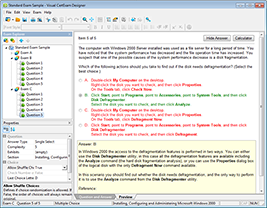Network Addressing
The network address (which can also be called the network number) uniquely identifies each network. Every machine on the same network
shares that network address as part of its IP address. For example, in the IP address 172.16.30.56, 172.16 is the network address.
The node address is assigned to, and uniquely identifies, each machine on a network. This part of the address must be unique because it identifies a particular machine—an individual— as opposed to a network, which is a group. This number can also be referred to as a host address . In the sample IP address 172.16.30.56, the 30.56 specifies the node address.
The designers of the Internet decided to create classes of networks based on network size. For the small number of networks possessing a very large number of nodes, they created the rank Class A network . At the other extreme is the Class C network , which is reserved for the numerous networks with a small number of nodes. The class distinction for networks between very large and very small is predictably called the Class B network .
Subdividing an IP address into a network and node address is determined by the class designation of one’s network.
summarizes the three classes of networks used to address hosts—a subject I’ll explain in much greater detail throughout this chapter. Summary of the three classes of networks
Summary of the three classes of networks
To ensure efficient routing, Internet designers defined a mandate for the leading-bits section of the address for each different network class. For example, since a router knows that a Class A network address always starts with a 0, the router might be able to speed a packet on its
way after reading only the first bit of its address. This is where the address schemes define the difference between a Class A, a Class B, and a Class C address. Coming up, I’ll discuss the differences between these three classes, followed by a discussion of the Class D and Class E addresses. Classes A, B, and C are the only ranges that are used to address hosts in our networks.
Network Address Range: Class A
The designers of the IP address scheme decided that the first bit of the first byte in a Class A network address must always be off, or 0. This means a Class A address must be between 0 and 127 in the first byte,
inclusive.
Consider the following network address:
0 xxxxxxx
If we turn the other 7 bits all off and then turn them all on, we’ll find the Class A range of network addresses:0 0000000 = 0
0 1111111 = 127
So, a Class A network is defined in the first octet between 0 and 127, and it can’t be less or more. Understand that 0 and 127 are not valid in a Class A network because they’re reserved addresses, which I’ll explain soon.
Network Address Range: Class B
In a Class B network, the RFCs state that the first bit of the first byte must always be turned on but the second bit must always be turned
off. If you turn the other 6 bits all off and then all on, you will find the range for a Class B network:
10 000000 = 128
10 111111 = 191
As you can see, a Class B network is defined when the first byte is configured from 128 to 191.
Network Address Range: Class C
For Class C networks, the RFCs define the first 2 bits of the first octet as always turned on, but the third bit can never be on. Following the same process as the previous classes, convert from binary to decimal to find the range. Here’s the range for a Class C network:
110 00000 = 192
110 11111 = 223
So, if you see an IP address that starts at 192 and goes to 223, you’ll know it is a Class C IP address.
Network Address Ranges: Classes D and E
The addresses between 224 to 255 are reserved for Class D and E networks. Class D (224–239) is used for multicast addresses and Class E (240–255) for scientific purposes, but I’m not going into these types



